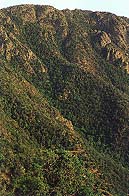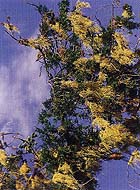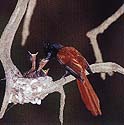THE UNIQUE CLOUD FOREST OF SAUDI ARABIA
by S. Newton
Pictures by Eichaker & Pambour
 Terms such as cloud forests usually evoke images of far-off places at high altitude, such as the Andes of South America or the land of 'Gorillas in the Mist' in central Africa. A similar ecological counterpart is the escarpment juniper forest of the Asir Mountains in south-west Saudi Arabia. Many readers may remember surprising images of beautiful forested areas in Michael McKinnon's TV series 'Arabia - Sand, Sea, Sky'.
Terms such as cloud forests usually evoke images of far-off places at high altitude, such as the Andes of South America or the land of 'Gorillas in the Mist' in central Africa. A similar ecological counterpart is the escarpment juniper forest of the Asir Mountains in south-west Saudi Arabia. Many readers may remember surprising images of beautiful forested areas in Michael McKinnon's TV series 'Arabia - Sand, Sea, Sky'.
Within the Kingdom, the NCWCD Raydah Reserve near Abha is probably the best example of the juniper forest that once covered much high altitude (above1800 m) ground. Raydah is unique as it encompasses a complete ecological cross-section through various vegetation zones, since it falls steeply from the rim of the escarpment at 2750 m to the floor of Wadi Jaw, 4 km away at 1250 m. The contrast in climate can be tremendous: cool, damp, cloudy and very temperate at the top, to hot, oppressive tropical conditions at the bottom.
Extensive tree coverage is naturally of limited occurrence in Arabia, a peninsula dominated by extremely arid deserts. Although we can find open acacia woodland in many wadis, the junipers at Raydah form a forest with trees reaching 15-20m. Juniper forest is most lush at the top of the escarpment on north or west facing slopes, with the trees draped in Usnea, a grey-green lichen. As one descends, a wider variety of trees occurs, with olive, Nuxia, pistachio and acacia all common in places. The forest peters out at about 1700 m in a zone of orange flowered buddleia and tree aloes. Scrub and open grassland dominate the more open, south facing slopes.
The forest is a very important place for birds and other less conspicuous wildlife, ranging from mammals to molluscs. To date, just over 100 birds species have been recorded in the Reserve but, given that about 500 have been recorded in the Kingdom, diversity of species per se is not what attracts ornithologists. The uniqueness of Raydah is that it is just about the only place in Arabia where virtually all our endemic terrestrial birds occur together. As a group, the world-wide distribution of these birds spans only the mountains in south-west Saudi Arabia, Yemen and parts of Oman. The remainder of the resident avifauna is dominated by tropical African species and it is the co-existence of these two groups that explains why NCWCD gives high priority to the study and conservation of Raydah's birds.
Amongst the many things we need to know are the particular habitats these birds prefer, what they eat, how long they live, how far they move, their breeding rates and seasonal abundance. In addition to the resident birds, a variety of migrants use the Reserve at different times of the year: a small number of African species arrives in spring to breed in south-west Arabia, with many more passing through in spring and autumn en route between Eurasian breeding areas and their wintering areas in Africa. Another small group is the winter visitors and European species such as Song Thrush, Black Redstart, Blackcap and Chiffchaff which can be common in the junipers.
 Food and habitat are often good ways of dividing bird communities into smaller units. Although not numerous, several species of birds of prey are present in the forest and associated mountain cliffs. The two largest breeding species are the Short-toed Eagle and the Long-legged Buzzard (often the distinctive black form): both eat mostly snakes and lizards, which they catch basking in more open areas. Smaller raptors include Barbary Falcon, Kestrel, both hunting small birds or rodents in open areas, and the Shikra, an African sparowhawk which catches small birds by pursuit through and over the forest.
Food and habitat are often good ways of dividing bird communities into smaller units. Although not numerous, several species of birds of prey are present in the forest and associated mountain cliffs. The two largest breeding species are the Short-toed Eagle and the Long-legged Buzzard (often the distinctive black form): both eat mostly snakes and lizards, which they catch basking in more open areas. Smaller raptors include Barbary Falcon, Kestrel, both hunting small birds or rodents in open areas, and the Shikra, an African sparowhawk which catches small birds by pursuit through and over the forest.
The two endemic Arabian partridges, whose diet mostly comprises grass seeds, are often conspicuous birds, perching on prominent, rocky knolls and calling loudly. The slightly smaller Philby's Rock Partridge*, with a grey cap, is most frequent at the top of the escarpment, whereas the larger Arabian Red-legged Partridge*, with more bold black and white head and facial markings, usually occurs at middle or lower altitudes.
Most medium and small sized birds are either insectivores or 'vegetarians' (e.g. granivores, frugivors or nectarivores). Different species occur in the more open areas, natural or man-made, and the forest itself. Areas along the paved road at the top of the escarpment or, for example, around the terraced farm in the centre of the Reserve are good places to see open-area species. The African Rock Bunting is a typical breeding species at the top; though often unobtrusive, it has a short, powerful song. The two serins, Arabian* and Yemen*, are inconspicuous, dull-coloured, seed-eating finches. The latter typically occurs on steep open slopes, whilst the former prefers open woodland and scrub. The Arabian Waxbill*, bright and delicately marked and with a blood red eye-stripe, is the smallest member of the finch family to occur at Raydah and is most common in grassy and scrub areas. Two iridescent jewels in the avifauna are the nectar-drinking Palestine Sunbird, which regularly inhabits scrub areas at mid altitudes, and the Shining Sunbird which is prevalent nearer the wadi. Other, insectivorous, birds of higher, more open areas include the South Arabian Wheatear*, the Little Rock Thrush and the felix race of Stonechat.
Larger non-passerine birds in the forest include the Arabian Woodpecker: this species is naturally insectivorous, though on occasions it will sap-suck. It seldom occurs in junipers but is more frequently seen in acacias where it digs most of its roosting and nesting holes. Three less common dove species breed in the Reserve; all are largely frugivorous, thriving on juniper berries and olive fruits. The Olive Pigeon, a large dark grey bird with bright yellow legs and bill is probably resident although it was only discovered in Arabia about ten years ago. Both the Dusky Turtle Dove (dark grey-brown, but its inner wing feathers have beautiful, rich red-brown edgings), most easily detected by its low-pitched 'cooing', and the Bruce's Green Pigeon, an exquisitely coloured African dove, are breeding visitors to the mountain forests and wadis of south-west Arabia.
Warblers and flycatchers are generally insectivores: the Yemen Warbler* is a dull, grey-brown bird with very skulking habits, though it can often be seen in junipers, climbing up the trunks, probing and pecking at the bark for insects in the same manner as a tree-creeper. It can be located by its very harsh, piercing rattling-laughing call. The Brown Woodland Warbler is one of the most vocal birds in the forest and will sing at any time of the day, sounding somewhere in between a Willow Warbler and Chiffchaff. Plumage is green-brown with a vivid yellowish wing panel. The African Paradise Flycatcher is, without doubt, the most impressive bird of the forest. Again, it is often highly vocal and, once the call is known, pairs or groups can be located easily, usually beneath the canopy along drainage lines and stream valleys. The typical plumage is a chestnut brown body with an iridescent blue-black head and bright blue eye ring. Males have spectacularly long brown or white tails and streamers. They appear very acrobatic during aerial pursuits to catch butterflies and moths. Two of the most abundant forest frugivores are the Yemen Linnet * and Yemen Thrush*. The linnets are perhaps the first eye-catching species that you are likely to encounter at Raydah, flitting above the canopy, singing, displaying and pursuing neighbours between March and July. They are recognizable by their trilling song and prominent white wing patches against a chestnut, grey and black plumage. The thrush is a little harder to pick up and, despite general brown-black plumage, it has distinctive yellow-orange bill and legs and an orange underwing only seen in flight. They are normally seen in juniper trees with good berry crops.
 Some forest species are more generalist feeders, apparently using both fruit and insects, depending on their seasonal availability. These include the warbler-like White-breasted White-eye and the widespread Yellow-vented Bulbul. A final mention should be made of one other endemic species that occurs at Raydah: The Asir Magpie*, a scarce resident in the forest, superficially like the European or North American races but with a startlingly different call.
Some forest species are more generalist feeders, apparently using both fruit and insects, depending on their seasonal availability. These include the warbler-like White-breasted White-eye and the widespread Yellow-vented Bulbul. A final mention should be made of one other endemic species that occurs at Raydah: The Asir Magpie*, a scarce resident in the forest, superficially like the European or North American races but with a startlingly different call.
Some of the most interesting birds at Raydah are entirely nocturnal: half an hour's listening around dusk can usually reveal three or four species that are seldom recorded during daytime. The Reserve supports two nightjar and three owl species. The Plain Nightjar has a long drawn-out churring call typical of many nightjars, whereas the Mountain Nightjar has an evocative, whistling call 'Wee-oo-wee-weerr' and was only discovered in Arabia a few years ago. The Senegal Scops Owl is the most numerous owl and its short 'purrp' call often echoes around well-forested areas around sunset. Hume's Tawny Owl and Spotted Eagle Owl are also present but are not such regular contributors to the sunset chorus.
Much of our time researching the bird populations is devoted to catching and marking resident species. All birds caught are ringed, weighed, measured and inspected for brood patches (proof of breeding activity in females) and moult. Some conspicuous species are also fitted with colour rings by which we can identify individuals without the need to retrap them. Many birds caught in spring 1992 were still present and breeding in the same locations three years later: included are some of the larger species such as the Yemen Thrush and Yellow-vented Bulbul, but also small species weighing 20 grams or less, e.g. Palestine Sunbirds, Brown Woodland and Yemen Warblers, White-breasted White-eyes and Arabian Serins. In contrast, the Yemen Linnets appear to be very mobile and are seldom faithful to a particular location except for the duration of the current breeding season. Several breeding or wintering migrants also seem site-faithful; for example Dusky Turtle Doves return to the same location to breed having over-wintered on the Tihama and a Black Redstart was trapped in two consecutive winters near the top of the Reserve. Presumably this bird must have bred in the interim somewhere in central Asia. The overall strategy of many juniper forest birds seems to be one of longevity, whilst breeding at relatively low rates, with clutches or broods of two or three typical.
The Raydah Escarpment is a unique environment, home to most of Arabia's endemic birds. We are only beginning to discover its secrets and there is still much to be learned.
(*indicates an endemic species)
Web Links | Subjects | Search
Arabian Wildlife. Volume 2, Number 3